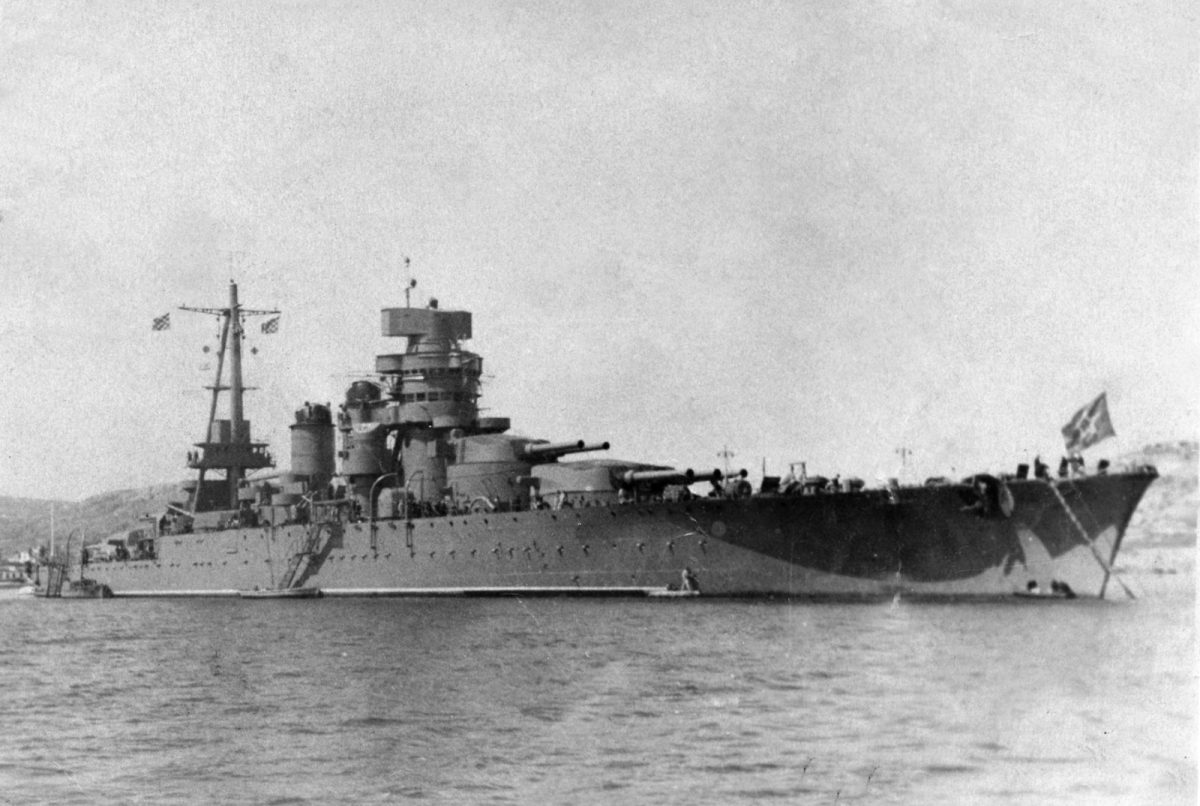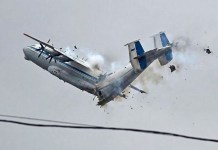The Russian Black Sea Fleet (BSF) has incurred a string of painful losses in the ongoing Ukraine war, which is fast approaching its fourth anniversary. However, none of these losses cost Russia more lives than the unfortunate tragedy that struck the Soviet battleship Novorossiysk seventy years ago.
On October 29, 1955, the Soviet BSF lost its flagship battleship of the time—the Novorossiysk—in what is still counted among the deadliest peacetime naval disasters in history.
More importantly, it is also counted among the most mysterious naval disasters in post-World War II history, due to the gaps in the investigation of the incident published by the Soviet Union and the circumstances of the accident.
The ship was originally an Italian battleship named Giulio Cesare (Julius Caesar), a Conte di Cavour-class dreadnought, which was launched by the Italian Navy in 1911 and commissioned in 1914. The ship served in both World War I and World War II, surviving very heavy combat through those years.
After Italy’s defeat in WWII, the 1943 armistice and subsequent Peace Treaties required Italy to cede warships as reparations. Most of the Italian Navy surrendered intact to the Allies at Malta in September 1943, and the Novorossiysk (then Giulio Cesare) was taken by the erstwhile Soviet Union.
On February 9, 1949, the ship arrived at the port of Vlore in Albania, marking the beginning of its career as a Soviet battleship. It was rechristened as Novorossiysk on March 5, 1949, and formally recommissioned in Sevastopol into the Soviet Black Sea Fleet.
Despite being the most potent ship in the Black Sea in terms of displacement and firepower, the Novorossiysk presented logistical and operational difficulties. It was an outdated WW1-era design in dire need of repairs, with many of its electrical systems broken and its internal components rusting or malfunctioning. Additionally, the ship suffered from chronic boiler and machinery issues.
The battleship’s condition was attributed to neglect by the Italian Navy during the period between the end of the war and its transfer to the Soviet Navy.
Since there was no way for the Soviet Navy to obtain spare parts for an old, rusty ship from Italy, the Soviets had no option but to repair it on their own. As a result, it underwent multiple refits driven by wartime damage, obsolescence, and the need to adapt an Italian warship to Soviet standards.
While some upgrades were completed, plans to replace the ship’s main battery were never realized. The ship now had a mix of old Italian and new Soviet components.
In 1955, when the disaster happened, the ship was serving as the flagship of the Black Sea Fleet and was also used as a training ship for naval cadets.
The Sinking Of Novorossiysk
The battleship Novorossiysk conducted a gunnery exercise in the Black Sea and then returned to Sevastopol in the afternoon of October 28, 1955. It was anchored in waters around 60 feet deep near mooring buoy 3, which was about 1,000 feet off the shore.
During this time, about 1500-1700 personnel were on board the ship, and the weather was calm, with light winds. Nobody on the ship foresaw what was coming for them.
In the dead of the night on October 29, 1955, at about 01:31 am, a massive explosion erupted directly beneath the Novorossiysk’s starboard bow. The explosion resulted in a hole measuring 1,614 square feet, about 68 feet long and 12 feet wide. The force of the blast was so intense that it caused the hull plates to fold inward by as much as nine feet.
Not just that, the explosion was so powerful that it awakened personnel at the nearby Sevastopol naval base, who responded almost immediately.
The force of the explosion penetrated all internal decks up to the weather deck. In the forward 66-foot portion, all starboard longitudinal frames were severed, and the entire bow part of the ship was believed to have momentarily bent five degrees upward from the rest of the vessel. Additionally, the transverse bulkheads were so severely deformed that watertight doors could not close properly, resulting in a massive inflow of seawater.
The Black Sea Fleet’s 29,000-ton flagship rolled over and sank two and a quarter hours after the explosion, while its own crew and rescue parties from neighboring ships were still frantically attempting to save the ship. As it rolled over, about 1,000 people who were still alive jumped to safety from the decks and superstructure.
When the ship sank in 50 feet of water, it had more than 600 men trapped inside.
A total of 617 Soviet sailors were killed in the explosion, which included 61 individuals dispatched from other vessels to assist. This catastrophe stands as the most devastating peacetime tragedy in the history of the Soviet Navy.
The rescue operations lasted days, and all the bodies were recovered from the wreck and the bay over the next few days.
Novorossiysk was salvaged on May 4, 1957. However, the Soviet Union did not disclose that a tragedy of that scale had happened along its own coast, and the only people who heard about the sinking were those who lost family members. In fact, only shards of information were available to Western naval intelligence due to stern Soviet information control, which kept the incident secret.
The world was first informed about the sinking by the Soviets in May 1988, shortly after Admiral of the Fleet Sergei Gorshkov passed away. But, in a significant turn of events, the incident sparked a host of conspiracy theories and is still believed to be the most mysterious and devastating peacetime accident in naval history.

Conspiracy Theories Surrounding The Tragedy
General Vyacheslav Malyshev, a respected engineering expert in the USSR, led the investigation into the Novorossiysk disaster. After inspecting the wreck, he noted that the damage pattern indicated an external explosion with inwardly bent hull plates.
The inquiry later concluded that the explosion originated on or near the seabed. The finding was supported by a large crater found when the ship was refloated.
Initially, the investigations blamed a German WWII mine, which purportedly had a warhead of 1,698 pounds. This conclusion sounded plausible because these types of mines were heavily laid in the Black Sea during the war and were only partially cleared after the armistice. However, many remained unconvinced by the official explanation for the sinking.
The origins of the explosion and the massive death toll were disputed, and dramatic new ideas filled with evil conspiracies started to emerge.
One of these conspiracy theories was that the battleship may have been sunk by on-board sabotage orchestrated by the KGB to discredit Admiral of the Fleet of the Soviet Union Nikolay Gerasimovich Kuznetsov.
Another explanation for the sinking of Novorossiysk was that Italian diversionary swimmers using human-torpedo chariots had targeted the battleship. According to this theory, the operation was planned by the infamous Italian neofascist and World War II commando Junio Valerio Borghese, also referred to as “The Black Prince.”
Borghese, who had apparently promised to sink the renowned Italian battleship before he died because he was upset that it had been given to the Soviets.
Later, Russian naval historians discovered some very curious details about the battleship’s demise. For one, they found that instead of the single explosion reported in the first investigation, there were two. One of them was beneath the hull, and one was next to it.
Second, the historians noted that, despite the blow that tore a hole in the starboard bow, the ship capsized and rolled over to the port side.
Third, the two massive craters in the harbor bottom beneath the ship were too deep and too large in diameter for German bottom mines of the type known to have been planted in the Sevastopol area and cleaned after the war. Interestingly, no mine fragments were found under, in, or around the battleship, and it was surmised that the blast had no characteristics of a torpedo.
A host of other observations also came to light. For instance, the watch officer on duty during the explosion believed the blast originated in unused machinery spaces, and suspected explosives had been placed on board before the ship’s transfer from Italy in 1949.
This was every bit bizarre, as noted by multiple experts. Meanwhile, a surviving officer reported hearing a low rumble and scraping sound before the explosion, which might have indicated the presence of an underwater vehicle. But this could never be confirmed.
Suspicions were also raised by several other circumstances, such as the fact that the harbor-defense boom and anti-submarine net protecting the Novorossiysk anchorage had been opened the evening before the explosion on orders from Sergei Gorshkov, the then-Black Sea Fleet Commander.
Some also pointed out that the hydroacoustic anti-submarine warfare listening station “Saturn 12” was down for repairs the day before the explosion, preventing it from detecting a submerged intruder.
These facts certainly cast doubt on the original investigation’s findings, suggesting that the sinking of this ship was more complicated —and perhaps even sinister. But exactly how this ship sank was never determined decisively.
- Contact the author at sakshi.tiwari13 (at) outlook.com
- Follow EurAsian Times on Google News




